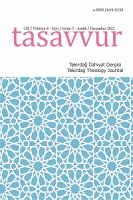Ortak Hadisler Bağlamında Ehl-i sünnet ve Şîa’ya Göre Firâset Rivayetinin Değerlendirilmesi II: Şiî Rivayetler
The Evaluation of Firâsah Narration According to Ahl al-Sunnah and Shia in the Context of Common Hadiths II: Shiite Narrations
Author(s): Mustafa TatliSubject(s): History of Islam, Contemporary Islamic Thought, Qur’anic studies
Published by: Tekirdağ Namık Kemal Üniversitesi İlahiyat Fakültesi
Keywords: Hadith; Shia; Common Narration; Firâsah; Shiite Narrations;
Summary/Abstract: The common narrations in the main hadith books in the tradition of Ahl as-Sunnah and Shia are an essential subject of examination in determining the relations within and between sects. In the significant part of these narrations, the two madhhabs differ by attributing different meanings to the common hadiths. It is understood that Shia's practices such as walaya, the necessity of the imam, being innocent and muhaddath of the imams are proven especially in the common hadiths related to the principles of faith. Aside from who is right, the meaning and wording differences in the common narrations could provide an understanding of the differences and formation processes between and within the sects. For example, the hadith of firâsah, one of the common narrations, has been discussed. An independent study concludes that the hadith of firâsah found a place in the Ahl al-Sunnah, especially in the Sufi tradition and did not pass on to the Ahl al-Sunnah from the Shia. This article has examined the common narrators of whether the hadith passed from Ahl alSunnah to Shia and has focused on whether there is an intellectual interaction. It has been determined that the meaning attributed to the understanding of firâsah by the Sufis among the Ahl al-Sunnah is similar to the imams' characteristic of being muhaddath in Shia. It has also been determined that the Shia made some additions to the hadith of firâsah and reached different conclusions from the Ahl as-sunnah. In addition, it has been seen that Ithnâashariya used the hadith of firâsah as evidence against other groups to confirm its justification in the sectarian divisions of the Shia.
Journal: Tasavvur Tekirdağ İlahiyat Dergisi
- Issue Year: 8/2022
- Issue No: 2
- Page Range: 781-805
- Page Count: 25
- Language: Turkish

